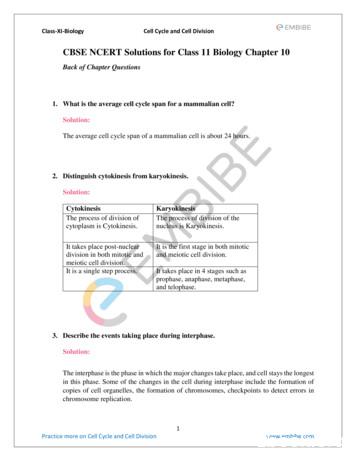Class-XI-Biology Cell Cycle And Cell Division
(i) haploid insects and lower plants where cell-division occurs, and(ii) some haploid cells in higher plants where cell-division does not occur.Solution:i)ii)Haploid insects include ants, bees, wasps, and in lower plants such asChlorella, Spirogyra and Chlamydomonas, the meiosis of zygote takes placepost-fertilization, which results in haploid organisms. This kind of cell cycle iscalled haplontic cell cycle.In higher plants, where flowers are the reproductive part of sexuallyreproducing plants, the antipodal cells and synergids which are haploid do notundergo cell division.14. Can there be mitosis without DNA replication in ‘S’ phase?Solution:Mitosis is the process of cell division, which requires the replication of DNA, to formnew cells. The replication of DNA takes place in the ‘S’ or Synthesis phase of the cellcycle, and it is required for equal distribution of DNA in the newly formed cells.15. Can there be DNA replication without cell division?7Practice more on Cell Cycle and Cell Divisionwww.embibe.com
Class-XI-BiologyCell Cycle and Cell DivisionSolution:Yes, DNA replication can take place without cell division, resulting in accumulation ofexcess of DNA within the cell and hence increase the cell density. In cell organelles suchas mitochondria and chloroplasts, the DNA replication takes place to replace the worn outor damaged cell organelles.16. Analyse the events during every stage of cell cycle and notice how the followingtwo parameters change(i) number of chromosomes (N) per cell(ii) amount of DNA content (C) per cellSolution:The stages of the cell cycle are Interphase, which consists of G1, S and G2 phase, whichis followed by the M phase. M phase or Mitotic phase has Prophase, Metaphase,Anaphase and Telophase ( Somatic cell division).Gamete formation is due to Meiotic division. Meiosis takes place in two successivestages: Meiosis I and Meiosis II. In human beings, the chromosome number is 2N or 46(23 pairs).Hence,i)The number of chromosomes (2N) per cell remains the same in the interphase,whereas in the Anaphase of Mitosis, the chromosome number increases to 4N,and at the end of cell division, the chromosome number is 2N, due to theformation of two daughter cells.In meiotic division, the chromosome number reduces to half, i.e., (N) at theend of Meiosis I. In the Anaphase II of Meiosis II, the chromosome numberdoubles (2N) and at the end of Meiosis II, the chromosome number reduces to(N), due to formation of four daughter cells.ii)The amount of DNA content (C) per cell remains the same in the G1 phase, however,in the S phase, the amount of DNA content doubles and it remains unchanged in theG2 phase. In the anaphase of Mitotic division, the DNA is equally distributed in thedaughter cell. Hence the amount of DNA remains the same, whereas, in Anaphase IIof meiotic division, the DNA content is reduced to half the amount per cell comparedto the parent cell.8Practice more on Cell Cycle and Cell Divisionwww.embibe.com
Class-XI-Biology Cell Cycle and Cell Division 1 Practice more on Cell Cycle and Cell Division www.embibe.com CBSE NCERT Solutions for Class 11 Biology Chapter 10 Back of Chapter Questions 1. What is the average cell cycle span for a mammalian cell? Solution: The average cell cycle span o
animation, biology articles, biology ask your doubts, biology at a glance, biology basics, biology books, biology books for pmt, biology botany, biology branches, biology by campbell, biology class 11th, biology coaching, biology coaching in delhi, biology concepts, biology diagrams, biology
of the cell and eventually divides into two daughter cells is termed cell cycle. Cell cycle includes three processes cell division, DNA replication and cell growth in coordinated way. Duration of cell cycle can vary from organism to organism and also from cell type to cell type. (e.g., in Yeast cell cycle is of 90 minutes, in human 24 hrs.)
The Cell Cycle The cell cycle is the series of events in the growth and division of a cell. In the prokaryotic cell cycle, the cell grows, duplicates its DNA, and divides by pinching in the cell membrane. The eukaryotic cell cycle has four stages (the first three of which are referred to as interphase): In the G 1 phase, the cell grows.
The cell cycle includes all of the events in the life of an individual cell, from cell division to the period when a cell is not dividing while it carries out it’s regular functions. We can thus divide the cell cycle into: A. Interphase: Period of cell cycle when cell is not dividing 1. G1 Phase: Cellular organelles begin to duplicate. 2.
1 Cell Cycle and Mitosis THE CELL CYCLE The cell cycle, or cell-division cycle, is the series of events that take place in a eukaryotic cell between its formation and the moment it replicates itself. These events can be divided in two main parts: interphase (
Figure 6-17a Essential Cell Biology ( Garland Science 2010) 21. Figure 6-17b Essential Cell Biology ( Garland Science 2010) 22. Figure 6-16 Essential Cell Biology ( Garland Science 2010) 23. 24. 25. Figure 6-19 Essential Cell Biology ( Garland Science 2010) 26.
(Biology-Miller & Levine) & OUHSD Recommended Labs Content Vocabulary Cell Structure 3 weeks Biology/Life Science, Cell Biology: 1c, 1d, 1e, 1f, 1g & 1j* Chapter 7 Cell Microscopy Lab Osmosis Lab 1. Prokaryotic cell 2. Eukaryotic cell 3. Nucleus 4. Cell membrane 5. Semipermeable 6. Phospholipids 7. Hydrophilic 8. Hydrophobic 9. Cytoplasm 10 .
Architectural Drafting Line Work Arrowheads are drawn freehand. The length of an arrowhead is the same dimension used for the height of lettering. The proportion of the length of the arrowhead to the width is 3:1 respectively. Arrowheads can be either open, closed, solid, or the traditional slash as shown. Other types of symbols can be used in place of the arrowhead or slash. These include .























